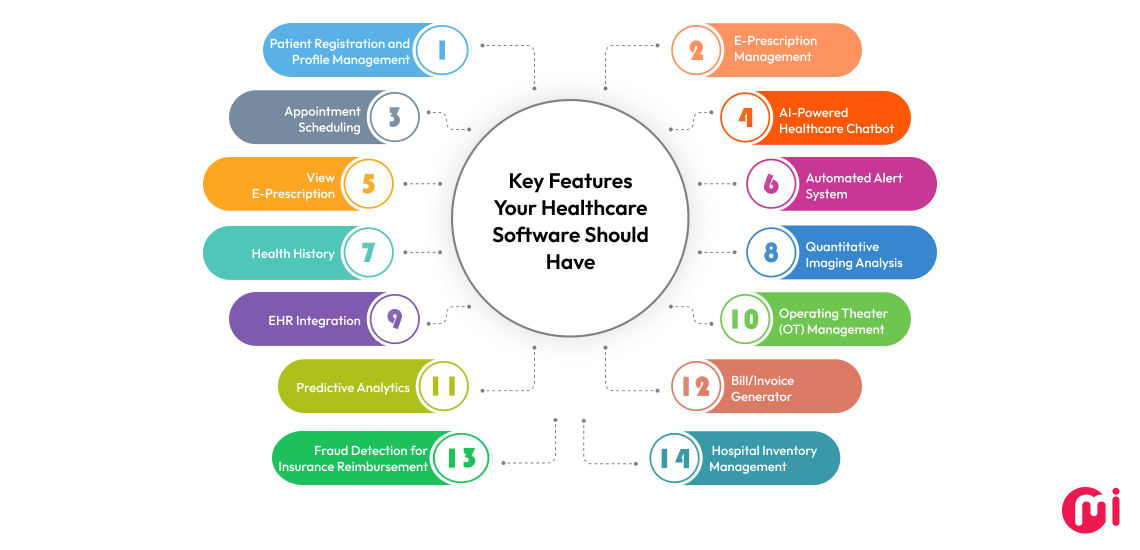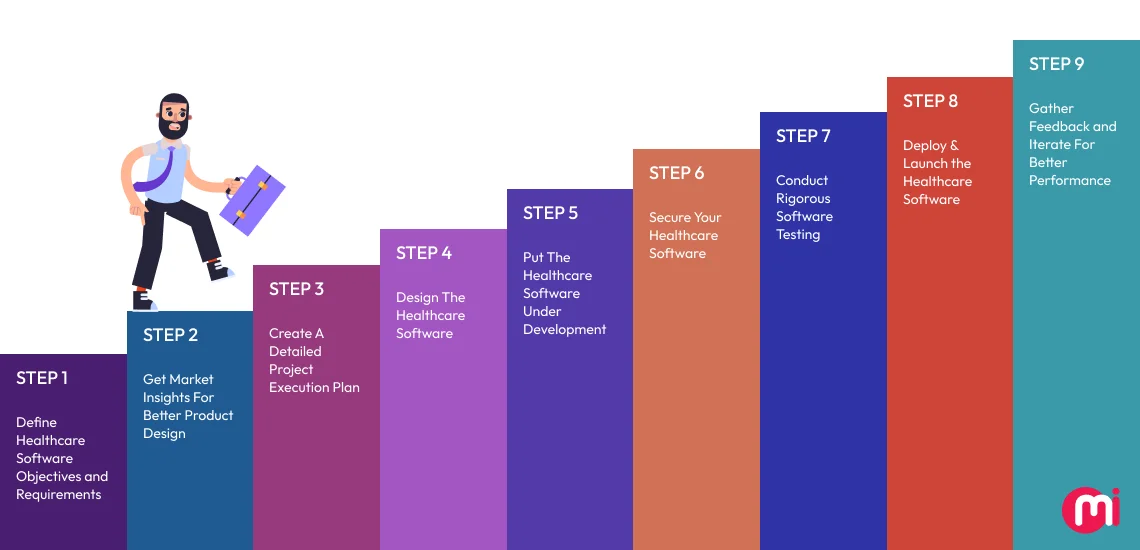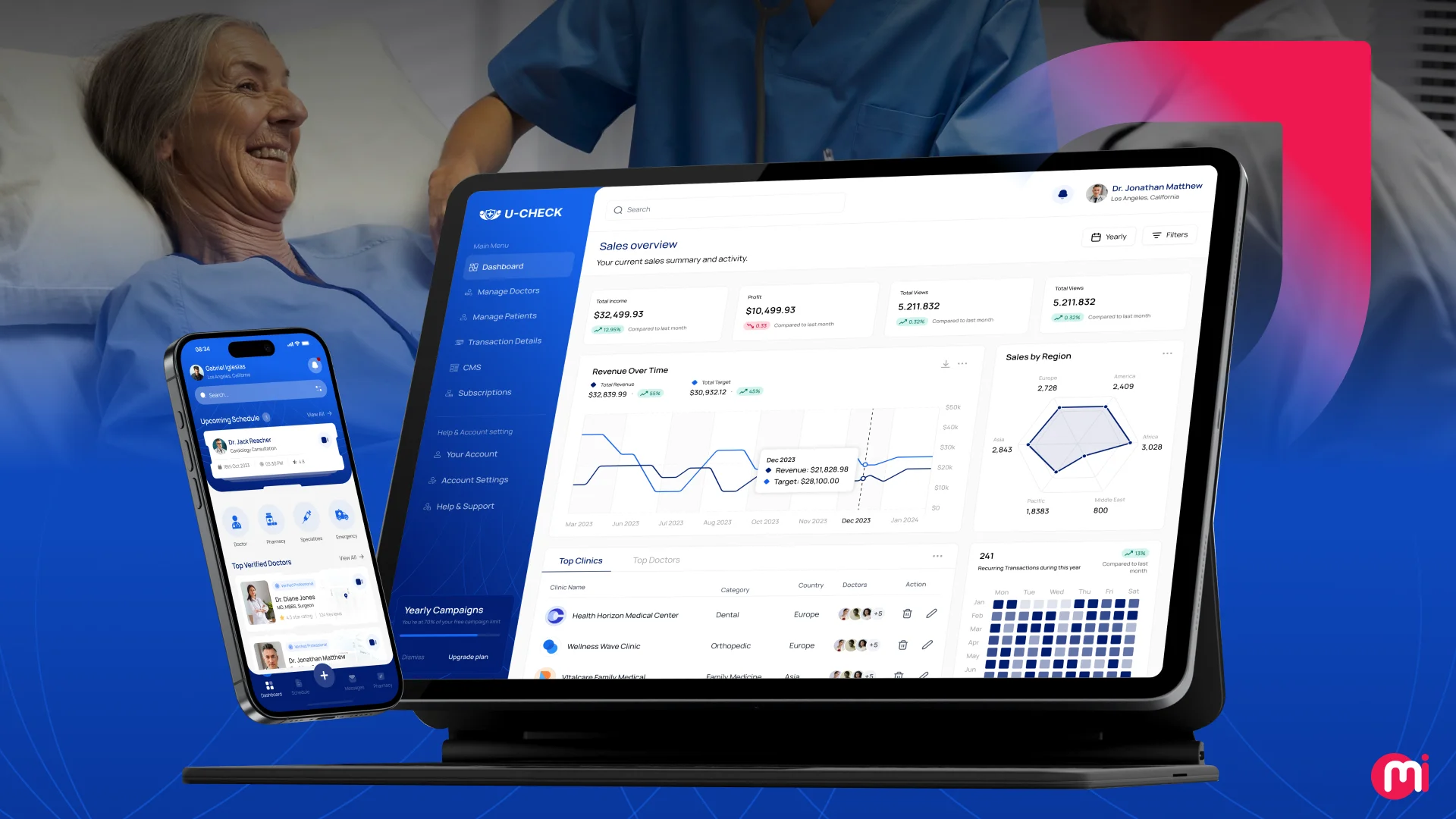A Comprehensive Guide to Healthcare Software Development
- Software
- September 9, 2024
From electronic health records to pharmacy management, healthcare software solutions can streamline and enhance various operations. Building a healthcare software solution requires careful planning and execution. Leveraging our years of expertise in the healthcare sector, we’ve created this guide to cover everything from benefits to key features to technical considerations essential for healthcare software development.
The healthcare industry is facing multiple institutions reporting challenges in managing patient data, streamlining workflows, and ensuring compliance with ever-changing regulations. Additionally, excessive administrative tasks can consume upto 30-40% of healthcare providers’ time that can lead to inefficiencies and burnout. Moreover, the lack of integration between different departments often results in communication breakdowns, delays in patient care, and even medical errors.
If not addressed, these medical errors can have serious consequences, contributing to casualties. According to one report, in the U.S., medical errors contribute to approximately 98,000 deaths annually.
A Statista survey of global citizens on healthcare falling short in their respective countries revealed that 63% of respondents in Poland felt their healthcare system was falling short, followed by Italy at 52%, Canada at 41%, Germany at 38%, the United Kingdom at 38%, and the United States at 33%.
In such a situation, having a comprehensive healthcare software solution onboard can be a game-changer. By automating routine tasks, enhancing data accessibility, and improving communication across departments, healthcare software not only alleviates these challenges but also boosts overall efficiency and patient satisfaction.
In this blog, we’ll guide you through the process of developing a custom healthcare software solution. We’ll cover everything from identifying the key features and benefits to understanding the critical technical considerations and compliance requirements.
Whether you’re looking to improve existing processes or implement one of the most impactful healthcare software solutions from scratch, this guide will provide the insights you need to succeed.
What Do Healthcare Software Solutions Comprise?
Healthcare software development solution or a medical software development solution, integrates multiple functions into a single platform, enabling healthcare providers to manage patient care, administrative tasks, and financial operations more efficiently.
Your healthcare software solution can integrate and comprise many disparate types of healthcare software modules into one ecosystem, such as:
- Electronic Health Records (EHR), a centralized system for storing and managing patient medical records.
- Patient Management System for scheduling appointments, tracking patient progress, and managing communication.
- Billing and Invoicing module for handling payments, insurance claims, and financial reporting.
- Telemedicine module that facilitates remote consultations and virtual care.
- Pharmacy Management module for managing medication inventory, prescriptions, and patient safety.
- Clinical Decision Support Systems (CDSS) for assisting healthcare providers in making clinical decisions by providing evidence-based recommendations and alerts.
- Laboratory Information Systems (LIS) for managing laboratory operations, including test orders, results reporting, and quality control.
- Radiology Information Systems (RIS) for managing radiology imaging workflows, including scheduling, image storage, AI/ML-powered imaging analysis, and report generation.
- Hospital Management System for streamlining and managing various hospital administrative, clinical, financial, and operational functions.
- Drug discovery system to support and enhance the process of discovering and developing new drugs.
Apart from these, there are many other features and types of healthcare software that you must consider developing based on your healthcare institution’s dynamics.
Every business in healthcare sector must invest in custom healthcare software development services to create an ecosystem tailored to their needs. In the latter section, you’ll come across many benefits to confidently make your decision for the same.
Why Should You Invest In Healthcare Software Development?
Investing in custom healthcare software development brings you a product that enhances patient care and various other medical and pharmaceutical operations, which is ultimately the goal of every healthcare institution. But the question remains: how does it achieve this?
Read on to discover the benefits of healthcare software development:
- Enhanced patient care through streamlined processes, reduction in medical data entry errors, personalized care, and improved decision-making, along with an ecosystem that facilitates easy communication between patients and healthcare professionals for accurate diagnosis and care.
- Increased efficiency and cost savings through automation of administrative tasks, streamlined healthcare workflows, and data-driven decision-making.
- Easy patient access to healthcare services via patient portals, allowing them to view their health records, schedule appointments with their preferred doctors, and track their diagnostic journey.
- Improved decision-making and patient care with an integrated healthcare software system that provides valuable insights from data collected at scale.
- A competitive advantage by offering seamless healthcare services with personalization and data transparency, making your services more convenient and trustworthy for precision and health record-driven diagnostics.
Investing in a healthcare software development solution not only improves the quality of care and operational efficiency but also positions healthcare organizations to build a better tomorrow for their growing institution.

Key Features Your Healthcare Software Solution Should Have
The healthcare industry is undergoing rapid transformation, driven by technological advancements and evolving patient expectations. This has led to a surge in demand for innovative healthcare software solutions equipped with advanced features. Let’s check out the features to implement into your healthcare software solution as per different accessibility requirements:

- Patient Registration and Profile Management: Enables the creation and management of patient profiles, updating personal information, and tracking health history. This feature is accessible to both patients and administrative staff.
- Appointment Scheduling: Allows patients to book appointments with doctors, while staff and providers can manage and organize schedules.
- View E-Prescription: After consulting with their doctor, patients can easily access their prescribed medications online, manage dosage information, and handle refills as prescribed.
- Health History: Patients can add their health history, such as allergy information and previous diagnoses, before consulting your institution, and access updated health information provided by your entity.
- EHR Integration: Healthcare professionals can access and update patient records, which will be accessible from other integrated platforms as well.
- Predictive Analytics: Healthcare providers and analysts can use predictive tools to forecast patient outcomes and improve care strategies.
- E-Prescription Management: During consultations, healthcare professionals can add e-prescriptions based on patient symptoms, which can then be transmitted to the in-house pharmacy. Major hospital chains like Apollo Hospitals in India, Cleveland Clinic & Johns Hopkins Medicine in the U.S., and IHH Healthcare in Malaysia, have such highly integrated healthcare systems.
- AI-Powered Healthcare Chatbot: This provides 24/7 healthcare assistance for first-level medical consultation, appointment scheduling and management, and more.
- Automated Alert System: This feature is used to get timely notifications of critical events, such as critical lab results, sudden deterioration of patients’ health, adverse drug reactions, patient falls, sepsis, and code blue, allowing healthcare staff to respond promptly and prevent adverse outcomes.
- Quantitative Imaging Analysis: This feature allows healthcare professionals to assess imaging reports, enhancing diagnostic accuracy.
- Operating Theater (OT) Management: Accessible to surgeons, OT staff, and administrative staff, this feature helps manage the scheduling, staffing, and arrange equipment of operating theaters to ensure smooth operations.
- Bill/Invoice Generator: Used by administrative staff and the finance department to generate and manage billing and invoices for patient services, vendor/supplier services, etc.
- Fraud Detection for Insurance Reimbursement: Assists healthcare and insurance facilities in monitoring transactions and patient data to detect and prevent fraudulent activities related to health insurance reimbursements. So hospitals can avoid insurance claim denial rates and insurance firms can save up finances.
- Hospital Inventory Management: Often utilized by administrative staff and supply chain managers to manage inventory, track supplies, and ensure the availability of necessary medical equipment.
Key Considerations for Effective Healthcare Software Development
Did you know that in the U.S., around 30% of EMR system implementations fail because physicians find it difficult to navigate the product? Well, this issue isn’t limited to EMRs; it’s common across all types of healthcare software.
Therefore, it’s crucial to review a checklist provided by our CTO when choosing a healthcare software product development approach:
- Focus on creating an intuitive and user-friendly interface that accommodates the needs of both healthcare providers and patients, enhancing usability and adoption.
- Design the healthcare software solution to seamlessly integrate with existing healthcare systems and other third-party applications, ensuring smooth data exchange and communication across platforms.
- Build a scalable architecture that can accommodate future growth, whether it’s increasing user numbers, adding new features, or expanding to new markets.
- Ensure the healthcare software can integrate with Electronic Health Records (EHR) systems, enabling healthcare providers to access and update patient records efficiently.
- Incorporate advanced data analytics tools that provide actionable insights, helping healthcare providers make informed decisions and improve patient outcomes.
- Consider the growing need for mobile access by opting for responsive designs or dedicated mobile app development services that allow healthcare providers and patients to access information on the go. You can also opt for the hybrid solution like PWA development to have a single code base optimized for both web and mobile access.
- Adhere to medical standards such as HIPAA, GDPR, HL7, DICOM, and ICD-10 to ensure the software can accurately handle medical data and facilitate proper diagnoses and treatments.
- Conduct rigorous testing and validation processes to ensure the healthcare software solution is free of bugs, meets performance expectations, and is ready for deployment in critical healthcare environments.
- Implement robust security measures, including encryption, secure authentication, and regular security audits, to safeguard sensitive patient information.
- Plan for ongoing maintenance, updates, and support to address evolving regulatory requirements, technological advancements, and user feedback.
From AI-augmented software development to Digital Immune Systems and Platform Engineering, read this blog to explore the top 15 software development trends.
A Step-By-Step Guide To Healthcare Software Development

While the development strategy may vary depending on the type of healthcare software or solution you choose, you can follow this generalized process for healthcare software product development to guide your healthcare software development project in the right direction:
STEP 1: Define Healthcare Software Objectives and Requirements
First, define the type of healthcare software you’re going to develop. Is the healthcare software solution for patient management, EHR, telemedicine, or something else?
Involve healthcare professionals from your institution, along with patients, administrators, and IT staff, to gather their input and define the software requirements for your healthcare institution.
Based on the region your healthcare institution is located in, determine which regulations and compliance standards your software solution needs to meet, such as HIPAA, GDPR, HL7, and others.
STEP 2: Get Market Insights For Better Product Design
Once you’ve identified the type of healthcare software you want to develop, it’s essential to study existing similar healthcare solutions to identify their strengths and weaknesses.
Conducting surveys and interviewing end-users can also be a valuable way to understand your focus group’s needs and identify pain points.
STEP 3: Create A Detailed Project Execution Plan
Based on your market and user research, you can proceed with defining the project scope, deliverables, and milestones, along with the necessary budget considerations and resource planning.
When defining the budget for your healthcare software development, be sure to also consider the technology stack and resource requirements, as well as selecting the right engagement model for the healthcare software project.
For the technology stack, you may want to consider the following:
| Web App Frontend Technologies | HTML5, CSS3, JavaScript Frameworks (React.js, Angular, or Vue.js) |
| Mobile App Frontend Technologies | Kotlin for Native Android App, Swift and Swift UI for Native iOS App, Flutter or React Native for Cross-platform App |
| Backend Technologies | Python (with frameworks Django, Flask, or FastAPI), core PHP or Laravel |
| Database Management Systems | PostgreSQL, MySQL, or MongoDB |
| AI/ML Technologies | TensorFlow, PyTorch, spaCy, NLTK, Apache Spark, Pandas |
| Cloud Infrastructure | Amazon Web Services (AWS), Microsoft Azure, or Google Cloud Platform (GCP) |
| Authentication and Authorization | OAuth 2.0 or JWT (JSON Web Tokens) |
| DevOps Tools | Jenkins, GitLab CI, CircleCI, Prometheus, Grafana, ELK Stack |
| Video Conferencing Tool | WebRTC |
For the engagement model selection, you can choose any of the two models mainly:
Fixed Cost Model – Best suited if your healthcare software development project has clear and well-planned requirements with minimal to zero anticipated changes.
Flexible Dedicated Hiring Model – Ideal if you want a healthcare software developer from outsourcing companies like MindInventory to work as your remote resource for your project with a varying scope, allowing for direct contact and dedicated support. This model is also known as hire dedicated developers.

STEP 4: Design The Healthcare Software
Hire UI/UX designers who are experts in designing healthcare software interfaces and can recommend interaction points to provide the best user experience.
They will also help develop wireframes and prototypes to visualize the software’s interface and functionality, while keeping product scalability in mind.
STEP 5: Put The Healthcare Software Under Development
Before diving into healthcare software development, ensure that the development plan is strategized according to agile methodology. Adopting an agile approach can provide significant benefits, not only by speeding up the software development lifecycle but also by building a high-end, performant solution.
But don’t misunderstand it with DevOps practice. Read our guide on Agile Vs. DevOps for better understanding.
Implement the front-end solution of the healthcare software considering all the pointers provided by the designer to make the interface intuitive and performant for a better user experience.
Prioritize server-side or backend development services to ensure efficient data processing, robust security, and seamless integration with other systems.
Ensure the healthcare software integrates smoothly with existing healthcare systems, such as EHRs, billing systems, and lab systems.
To avoid panic from the start, you can also start your healthcare software development with MVP development services to build, test, and iterate your solution as per evolving requirements. This incremental approach offers not only ease of development but also cost benefits.
STEP 6: Secure Your Healthcare Software
Implement encryption for data at rest and in transit to protect patient information. Additionally, plan to incorporate two-factor authentication, along with role-based permissions, to ensure that only authorized personnel can access sensitive data with your custom healthcare software solution.
STEP 7: Conduct Rigorous Software Testing
Ensure thorough testing of your healthcare software against all functional and non-functional requirements. This includes unit testing, integration testing, user acceptance testing, performance testing, and more, to ensure your healthcare solution is ready to provide a smooth and secure user experience.
At MindInventory, we offer comprehensive QA & software testing services using both manual and automated QA practices to deliver robust software solutions to our customers.
STEP 8: Deploy & Launch the Healthcare Software
After completing all necessary software quality checks, proceed with deploying the software in the live environment, ensuring that all systems are properly configured and operational.
Following deployment, request your software development team to provide training for end-users, including healthcare providers and administrative staff, to ensure smooth adoption.
STEP 9: Gather Feedback and Iterate For Better Performance
After deployment, monitor the healthcare software solution for any issues and provide ongoing support. Regularly collect feedback from users to identify areas for improvement. Use this feedback to make necessary updates and improvements, ensuring the software evolves with changing needs.
The healthcare sector is growing as people become more health conscious. Let’s explore the top healthcare app development trends that will dominate in 2025.
Challenges in Healthcare Software Development
Healthcare software development presents unique challenges due to the critical nature of the healthcare industry, regulatory compliance requirements, and the complexity of medical data. Here are some of the key challenges faced by business owners, users, and developers:
- Healthcare organizations must adhere to strict regulations like HIPAA, GDPR, and local data privacy laws, making software compliance complex and time-consuming.
- Protecting sensitive patient data is paramount as well as challenging, requiring business owners to invest in robust security measures to prevent data breaches and maintain patient trust.
- Integrating healthcare software with existing systems and electronic health records (EHRs) can be challenging due to varying standards and formats.
- Developing healthcare software can be expensive and time-consuming, particularly when dealing with complex systems and rigorous testing requirements.
- Users may face difficulties integrating new software with their existing workflows and systems. So, having support from IT staff is crucial.
- Additionally, healthcare data is often complex, unstructured, and subject to change. Therefore, it’s important to hire software developers with experience in healthcare projects to develop a system, meeting the industry standards.
How Much Does It Cost To Develop Healthcare Software?
You can estimate the cost for healthcare software development to range from $10,000 to $250,000 or more, depending on several factors, including the complexity of the application, the features required, and the expertise of the development team.
Based on project complexity, you can expect the following cost ranges:
- Basic healthcare applications: $10,000 to $30,000
- More complex applications, especially those involving advanced features like telemedicine and AI: $70,000 to $250,000 or even higher.
Additionally, you can expect a cost breakdown based on the software development services you choose:
| Services | Cost Range |
| Planning and Design | $2,000 – $8,000 |
| Development | $10,000 – $50,000 |
| Testing and QA | $3,000 – $7,000 |
| Deployment | $3,000 – $7,000 |
| Security and Compliance | $5,000 – $8,000 |
| Maintenance and Support | $5,000 – $10,000 (annually) |
| Marketing and Launch | $10,000 -$15,000 |
There are additional factors that also influence the cost of healthcare software development, from which types of healthcare software also plays a significant role.
For telemedicine software development like Doctor On Demand, the cost can reach up to $200,000.
Remote patient monitoring software development solutions can range from $8,000 to $400,000, depending on complexity. The reason behind this higher cost estimation can be obvious – as there will be a need for computer vision solutions and IoT enablement.
EHR software development costs can vary significantly based on specific requirements and integration requests.
Therefore, consider all the factors mentioned here for better budget planning.
Why Choose Mindinventory For Healthcare Software Development Services?
Approaching healthcare or medical software development is complex and requires careful consideration of many factors, as outlined in this blog. Having support from healthcare software development experts can be invaluable.
MindInventory is a preferred healthcare software development company for many well-known businesses in the healthcare and wellness industry, including EnneaApp (since 2011), Helponymous (now known as HeadHelp), and the telemedicine platform Waitless and Dentalcare.
These businesses have selected MindInventory to be their technology partner over other healthcare software service providers based on the following commitments:
- Extensive experience working on variety of healthcare software development projects
- Strategic adherence to industry standards and compliance, such as HIPAA, GDPR, HL7, etc.
- DevOps engineers and Scrum masters onboard for project management and governance
- Software developers who are not only technical experts but also skilled communicators with a customer-centric approach
- A strategic and transparent reporting system to keep you updated on project progress
- A 90% talent retention ratio, ensuring that your project is managed by the same team throughout with minimal handovers
With these value propositions from a healthtech solution provider, why miss to partner with such? Share your project requirements, and our business team will get back to you within 24-72 hours!
FAQs About Healthcare Software Development
The latest healthcare software development trends include AI and machine learning for predictive analytics, telemedicine for remote care, interoperability for seamless data integration, blockchain for data security, wearable health devices and IoT, cloud computing for scalability, patient-centric apps, advanced data analytics, voice technology, regulatory compliance and cybersecurity, augmented and virtual reality, and personalized medicine.
For selecting a healthcare software development company one must select a company with proven experience in healthcare projects, expertise in relevant technologies, a strong understanding of industry regulations, and a track record of successful implementations. Consider their approach to project management, customer support, and their ability to provide transparent reporting and maintain a high talent retention ratio.
Post-deployment considerations for healthcare software include monitoring software performance, providing ongoing support, collecting user feedback for improvements, ensuring regular updates, conducting regular security checks, and maintaining compliance with evolving regulations.
On average, it can range from a few months to over a year. The development time for healthcare software can vary widely depending on the project’s complexity, features, and the development team’s expertise.
Healthcare software should be updated regularly to address bugs, security vulnerabilities, and compliance changes. You can aim to update your healthcare software every few months or as needed based on user feedback and evolving industry standards.













